As people spend more and more time online, the role of the web designer has become increasingly crucial.
As a web designer, it's your job to stay on top of new techniques, technologies, and tricks that continue to emerge at a phenomenal rate. Additionally, you also need to run your business -- including finding clients, filing accounts, and potentially hiring and managing staff.
Whether you're a web designer or considering hiring one for your company, it's critical you know about the current challenges and opportunities in the web design industry.
Here, we'll cover some of the most essential web design stats for 2020 from Sitejet's new State of Web Design survey for 2020 and beyond.
Biggest Challenges & Pain Points
We’ve touched on it already, but when it comes to daily challenges, customer acquisition is far and away the most commonly cited pain point.
In fact, nearly half of web designers say that, more than any other aspect of their job, they find it hard to discover new clients.
The next most commonly cited pain point was profitability and pricing, while other responses such as keeping up with industry standards (10%), time management (8%), difficult clients (7%), and team management (2%) lagged way behind.
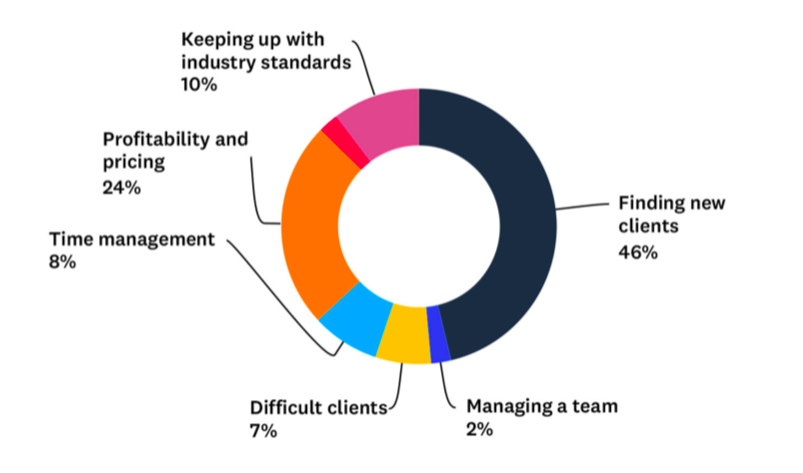
Things Web Designers Love
Unsurprisingly, when asked about their favorite parts of web design, the overwhelming majority focused on the creative process.
The actual process of building beautiful websites is what attracts most people into the profession, and it seems fair to say that it's what keeps them motivated years later.
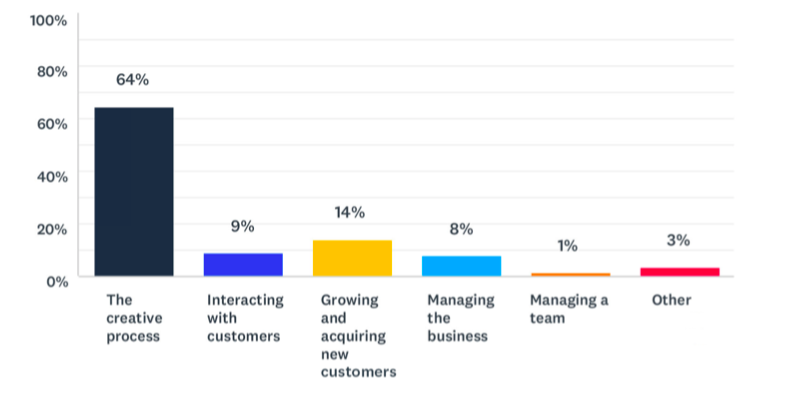
Things Web Designers Dislike
When asked what they dislike about the web design process, customer acquisition was again the most common reply. This was followed up by just under one in four web designers who say that managing the business is their least favorite part of the job.
These results, when evaluated together, tell us that web designers tend to enjoy the creative parts of the role, but are forced to reluctantly take up the 'other bits' such as marketing and management, to help facilitate what they really love to do.

How long does it take to create a website from scratch?
In essence, the ‘product’ that web designers sell is their time. And, since so many cite concerns over profitability in pricing, it’s interesting to consider how many hours it actually takes to build a website with modern tools and technology.
The results here could hardly be more evenly split, with a wide and varied response. Incredibly, while one in five web designers say they typically build websites in 10 hours or less, one in 10 told us they take 61 hours or more.
However, the majority (60%) of respondents settled around the mid-range, between 11-20 (31%) and 21-40 hours (29%).

How often do web designers update their clients' sites?
In the words of Leonardo da Vinci, "Art is never finished -- only abandoned." That’s the case with great websites, too. After those hours invested in the initial build, web designers often have to continue running and managing their clients’ websites, actioning changes, communicating with clients, and generally keeping the websites they build fresh and up-to-date.
In fact, only 11% of web designers say their clients have the ability to update their own websites once built.
When asked how often they typically have to update their clients’ websites, the numbers again vary wildly. However, more than seven in 10 web designers say it’s at least quarterly, with the most commonly cited response (30%) claiming that they typically update client websites on a monthly basis.
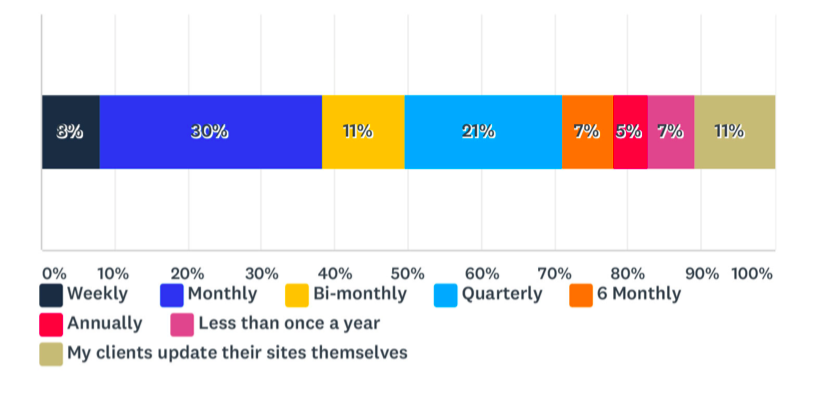
How do web designers communicate with their clients?
For around 90% of web designers, there’s some element of ongoing client communication and collaboration. How is that managed?
The research suggests that the vast majority of client communication takes place via email, which is used by 96% of web designers. 83% supplement that with phone or video calls, while the numbers for SMS (29%), project management systems (15%), file transfer tools (15%) design platforms (14%) and Slack (13%) lag way behind.
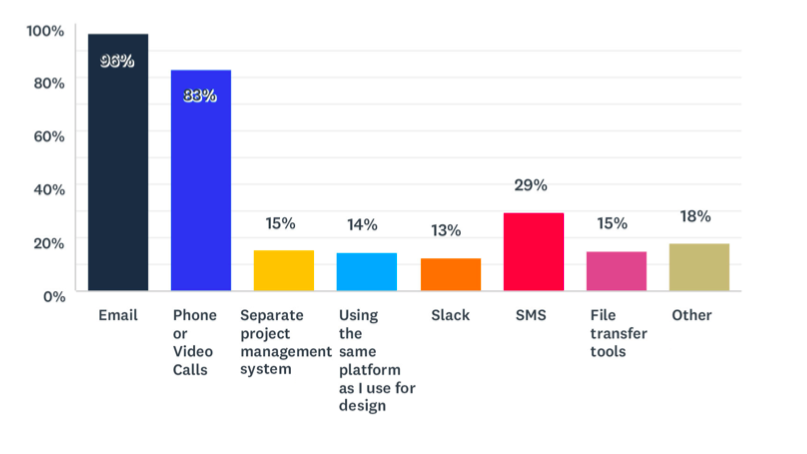
When we asked web designers to just select the main communication channel they used, around three-quarters chose email, followed by 16% who selected phone.
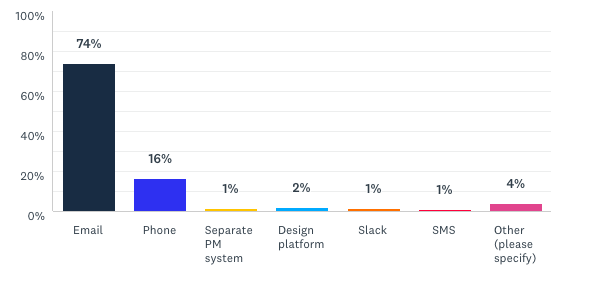
In short, there seems to be a huge reliance on email.
How do web designers get new clients?
Ultimately, customer acquisition is a major challenge cited by a huge number of web designers.
It’s interesting, then, to consider which channels they feel are most effective at bringing them new business.
The runaway leader here is word-of-mouth marketing, cited by 71% of respondents as being their number one channel for finding new clients.
Others have dabbled in content marketing and SEO (6%), social tools like Facebook (3%) and LinkedIn (1%), and email marketing (4%) but these are comparatively small numbers.

How do consumers browse the web?
The Sitejet study didn’t just quiz web designers about their daily work. It also asked for the thoughts and opinions of the everyday web consumer.
We all know that mobile browsing is a big deal, but, interestingly, it feels like rumors of the death of desktop have been greatly exaggerated. When asked how respondents mainly browse the web, over 70% of respondents told us they mainly browse on desktop.
Of course, that’s not to say that they don’t also browse on mobile -- but with so many people browsing mainly on desktop, it’s important to not put all your eggs into one basket.

The importance of usability …
Usability is one of the big buzzwords in modern web design and it’s unsurprising that it seems to have such a big effect on website users. This mainly applies to responsiveness, design quality, and load speed.
We found that:
- 93% of people have left a website because it didn’t display properly on their device.
- 90% of people have left a website because it was badly designed.
- 93% of people have left because a website didn’t load quickly enough.
Ultimately, these results demonstrate the critical importance of usability for any website's long-term success.
In summary …
That’s a lot of numbers, right? Here are the key takeaways:
- Web designers are ‘reluctant administrators’ who love to create - much more than they love to manage and market their businesses!
- There’s an insanely wide variance in how much work is involved in creating and managing websites, and it’s difficult to shake the feeling that a lot of web designers are spending way longer than they need to on their work. This potentially explains why around a quarter of web designers struggle with profitability and pricing.
- Email, for all its faults, remains THE dominant communication channel for web designers to work with their clients.
- Desktop browsing is far from dead, with a size-able chunk of the online population still browsing mainly on desktop, rather than mobile or tablet.
- Tolerance for shabby design, sluggish performance or unresponsive design is at an all time low, with more than 9 out of 10 people admitting they won’t hang around on a website that doesn’t tick these boxes.
It is an fantastic article. you are providing an unique and valuable information.
ReplyDeleteAngularJS training in chennai | AngularJS training in anna nagar | AngularJS training in omr | AngularJS training in porur | AngularJS training in tambaram | AngularJS training in velachery
very nice blogger.......................!!!
ReplyDeleteCyber Security Training Course in Chennai | Certification | Cyber Security Online Training Course | Ethical Hacking Training Course in Chennai | Certification | Ethical Hacking Online Training Course |
CCNA Training Course in Chennai | Certification | CCNA Online Training Course | RPA Robotic Process Automation Training Course in Chennai | Certification | RPA Training Course Chennai | SEO Training in Chennai | Certification | SEO Online Training Course